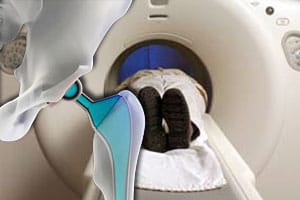
A new study suggests that Magnetic Resonance Imaging (MRI) can provide early detection of failing, or potentially failing, metal-on-metal hip (MoM) implant devices. According to study results presented at the 2013 Annual Meeting of the American Academy of Orthopaedic Surgeons (AAOS), such early detection can lead to earlier revision surgery, which can help minimize risks […]
 A new study suggests that Magnetic Resonance Imaging (MRI) can provide early detection of failing, or potentially failing, metal-on-metal hip (MoM) implant devices.
A new study suggests that Magnetic Resonance Imaging (MRI) can provide early detection of failing, or potentially failing, metal-on-metal hip (MoM) implant devices.
According to study results presented at the 2013 Annual Meeting of the American Academy of Orthopaedic Surgeons (AAOS), such early detection can lead to earlier revision surgery, which can help minimize risks for more tissue damage and pain.
The Academy said that researchers reviewed MRI images for 70 patients who underwent revision surgery following a failed metal-on-metal implant. The researchers assessed the MRI images for tissue damage, swelling, and other characteristics.
The study revealed that MRIs are very sensitive and specific to locating tissue damage in metal-on-metal total hip replacement (THR) patients. The Academy noted that early identification of patients who are risk for adverse reactions associated with failed metal-on-metal hip implant devices, could help in earlier, more timely, revision surgery, should that be needed. Earlier revision surgery can also help to minimize pain and potential damage to hip tissue.
The Acadamy’s Annual meeting also featured an educational session entitled “Optimizing Management of Patients with Metal-on-Metal Hips,” which involved seven orthopaedic experts discussing metal-on-metal hip failure identification and treatment. Also, last December, the Academy issued an Information Statement on metal-on-metal Hip Arthroplasty (replacement) recommending a “low threshold” for when to begin evaluating patients with these devices as, “early recognition and diagnosis will facilitate the initiation of appropriate treatment prior to significant adverse biological reactions.” The statement, said the Academy, provided a detailed overview outlining diagnostic and treatment methods to help minimize patient discomfort; when to quickly initiate treatment; and when to conduct revision surgery, should that be deemed necessary.
Metal-on-metal hip implant devices were created for greater durability and longevity and with the intention that the seemingly stronger components would be far superior over their more traditional counterparts that are constructed with plastic or ceramic elements. In recent years, the metal devices have come under fire for failing at unexpectedly high rates and leaving patients with significant and, often, life-long injuries. In fact, some experts say that European and American regulators worked to ensure patients were unaware of the devices’ risks and many have criticized device makers for placing profits before patient safety.
The U.S. Food and Drug Administration (FDA) also recently stepped in, just issuing new guidelines to patients implanted with the ASR and other all-metal hip replacements. Among other things, the agency advised that physicians conduct physical examinations, diagnostic imaging, and metal ion testing, as needed. The agency also proposed stricter regulations that would require manufacturers to prove the implants are safe and effective before selling them.
From a legal standpoint, these changes are a significant step in attempting to hold manufacturers responsible for dangers associated with their products.


